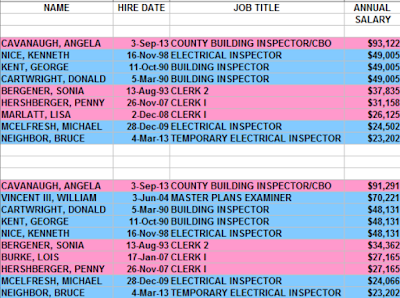This blog is the second in a series of updates on The Stark County Political Report April, 2014 series analyzing whether or not Stark County government has a good track record in achieving gender equity in its employment practices.
On Monday (LINK), The Report did an update assessment of Stark County auditor Alan Harold's record.
Harold has only been auditor for a little over five years. While much inequity flowed under the bridge before he ever set foot in the auditor's office, yours truly figures that five years is enough time for him to have made some progress in righting the wrongs that he inherited.
Sad to say but the SCPR thinks Harold (held in high regard overall as auditor [see blog on his #2 ranking as on the the SCPR "Top 10 List" of Stark County Political Subdivision Elected Officials]) needs to improve in promoting women in his office to higher paying, more responsible position within his office.
Today, we look at the Stark County commissioners (LINK to webpage) and their 2015 performance as measured against the base year 2014.
Later this year, the SCPR will update this series to show what if any progress in gender equity the commissioners have made from June, 2015 through June, 2016.
Here are the charts:
STARK COMMISSIONERS: ADMINISTRATION
Interesting, no?
The spread:
- between the "on average" women's salary grew from $44,307 compared to "on average" men's $66,305 in 2014
- to
- between the "on average" women's salary grew from $37,670 compared to "on average" men's $86,523 in 2015
The commissioners deserve credit for promoting one woman from within the administrative staff so that she gained 19% over her former salary.
Another female employee was paid more (9%) in 2015 over 2014 but because as a part-time employee she worked more hours.
The primary reason the spread grew was that the commissioners hired a man to be the county's human resources director at $76,502.
How ironic is that?
STARK COMMISSIONERS: FACILITIES
Other than 16.67 increase for the facilities manager position (2015 over 2014), the 2015 graphic is a much better picture for the facilities payroll.
That the commissioners found it necessary to go outside the existing employee ranks to find a new manager is an indictment of there being in place a program to bring a lower ranking (pay wise) employee (and God forbid, perhaps even a female) to the top spot.
Well, Olson, do you really expect that a woman could be in charge of county facility (mostly buildings) maintenance, rehab and the like? After all, this is a man's world isn't it?
STARK COUNTY COMMISSIONERS: BUILDING INSPECTION
The above numbers seem to indicate that even being a union member does not help the women of Stark County Building Department have a roughly similar payroll in terms of "on average pay."
If one includes the department head Angela Cavanaugh, then women do considerably better than men.
However, as the SCPR is led to believe, Cavanaugh is the ONLY non-union employee in the department.
So it is not an "apples to apples" comparison to include her.
The reality is that notwithstanding supposed union protection women other than Cavanaugh are relegated to (relative to inspector/examiner jobs) low paying clerical positions.
In this segment of today's analysis, The Report does not get into comparing increases in 2015 over 2015 inasmuch such in the case of the Building Department is controlled by union contract except, of course, for Cavanaugh.
One final note.
Yesterday, the SCPR got involved in a discussion with readers of this series of blogs about the blue (men), pink (women) graphic scheme devised by the SCPR to show "apparent" inequity in county government on pay equivalency and opportunity for promotion.
(Paraphrased discussion)
"You know, Martin, it is an oversimplification to show gender pay comparisons in blue and pink."
Response:
"Of course, it is. The SCPR understands that gender inequity has been many years in the making."
"And there are a number of factors which make it difficult to achieve equity. A number of those factors are American society wide in the sense that family and institutional (e.g. education) structures of socialization are not keeping pace with the expectations of the modern woman."
"Nonetheless, it is the responsibility of government to provide a quality of leadership that is capable of mitigating the "difficult factors" on the pathway now inculcated in American law towards achieving what is fair in the public workplace."Accordingly, the SCPR will continue to annually assess how well Stark County leadership does incrementally (year by year) in improving gender equity in Stark County government.










No comments:
Post a Comment